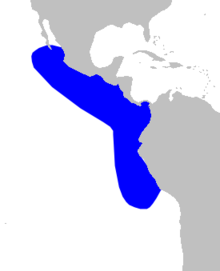- Pygmy beaked whale
-
Pygmy beaked whale 
Size comparison against an average human Conservation status Scientific classification 
Kingdom: Animalia Phylum: Chordata Class: Mammalia Order: Cetacea Family: Ziphiidae Genus: Mesoplodon Species: Mesoplodon peruvianus Binomial name Mesoplodon peruvianus
Reyes, Mead, and Van Waerebeek, 1991
Pygmy beaked whale range The pygmy beaked whale (Mesoplodon peruvianus), also known as the bandolero beaked whale, Peruvian beaked whale and lesser beaked whale, is the smallest of the mesoplodonts and one of the newest discoveries. There were at least two dozen sightings of an unknown beaked whale named Mesoplodon sp. A before the initial classification, and those are now believed to be synonymous with the species. Physical evidence of the species was first described in 1991 from a skeleton and a rotting carcass found in Bahia de La Paz, Baja California in 1990.
Contents
Physical description
The body of the pygmy beaked whale is the rather typical spindle shape of the genus, although the tail is unusually thick. The melon is somewhat bulbous and slopes down into a rather short beak. The mouthline in males has a very distinct arch with two teeth protruding slightly from the gum line before the apex. The coloration is typically dark gray on the top and lighter below, especially on the lower jaw, throat, and behind the umbililicus. Males may have a distinct pale "chevron" patterns on their backs. The size for this species in only around 4.5 meters (13 feet) long in mature animals, and around 1.6 meters (5 ft) when born.
Population and distribution
This beaked whale has been recorded in the eastern tropical Pacific between Baja California and Peru through sightings and strandings. Another specimen, apparently of the same species, washed up in New Zealand, which indicates a presence in the western Pacific as well. No population estimates have been made.
Behavior
Little is known about the group behaviors of this whale, and small groups have been seen. Stomach contents reveal at least one specimen is a fish eater, as opposed to the squid normally eaten by the genus.
Conservation
This species may be quite vulnerable to gillnets in Peru, since scientists found six dead adults in a very small sample. However, there is not enough evidence to determine anything about the species.
Specimens
- MNZ MM002142, collected from Oaro overbridge, south of Kaikoura, New Zealand, 19 October 1993.
References
- ^ Taylor, B.L., Baird, R., Barlow, J., Dawson, S.M., Ford, J., Mead, J.G., Notarbartolo di Sciara, G., Wade, P. & Pitman, R.L. (2008). Mesoplodon peruvianus. In: IUCN 2008. IUCN Red List of Threatened Species. Downloaded on 24 March 2009. Database entry includes a brief justification of why this species is of data deficient.
Sources
- Encyclopedia of Marine Mammals. Edited by William F. Perrin, Bernd Wursig, and J.G.M Thewissen. Academic Press, 2002. ISBN 0-12-551340-2
- Sea Mammals of the World. Written by Randall R. Reeves, Brent S. Steward, Phillip J. Clapham, and James A. Owell. A & C Black, London, 2002. ISBN 0-7136-6334-0
External links
- Cetaceans of the World
- CMS
- Whale & Dolphin Conservation Society (WDCS)
- Pygmy Beaked Whale - ARKive bio
- Peruvian Beaked Whale - The Beaked Whale Resource
Categories:- IUCN Red List data deficient species
- Toothed whales
- Ziphiids
- Mesoplodont whales
- Megafauna
Wikimedia Foundation. 2010.

